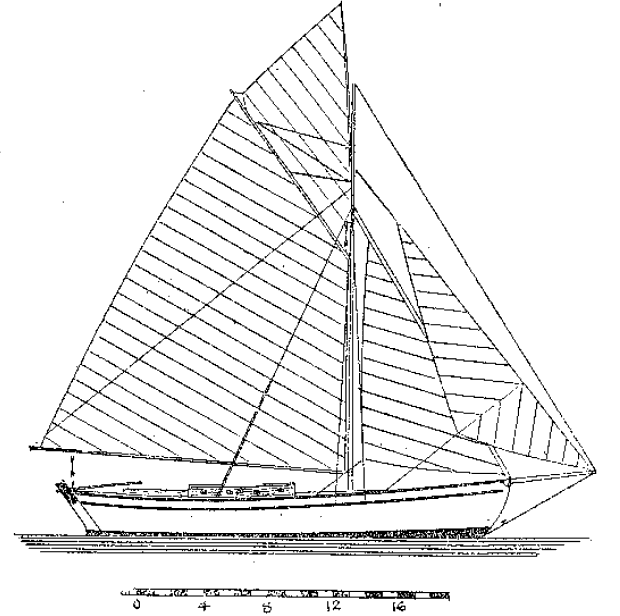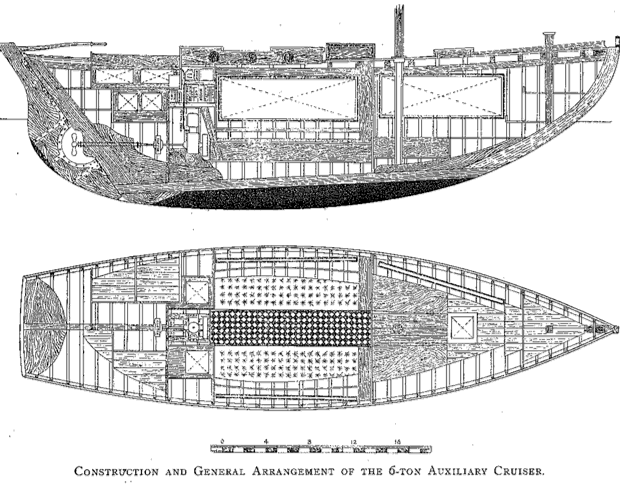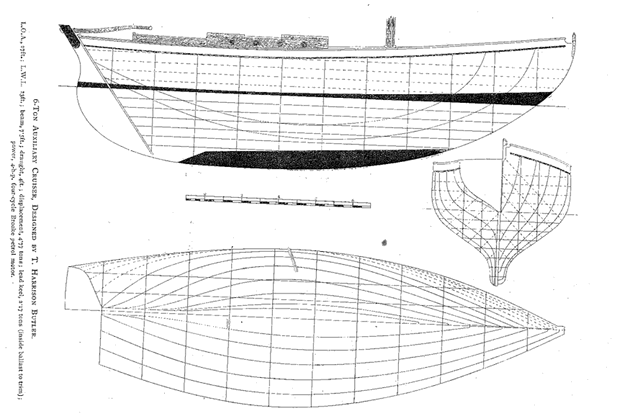| | 
The rule shown is 20 feet in length, the waterline length is 23 feet
The Leamington Spa in Perspective
This design was published across two and a half pages in Yachting Monthly, January 1911, when Harrison Butler lived in Leamington Spa. In the article written to accompany the design the theme of affordable boating for the common man is writ large; the design cuts cost by going for ease and simplicity of construction. However, perhaps the sacrifice of some key features, and the resulting discomfort, was not what the yachtsman of 1911 was after. The fact is, as far as is known, no yachts were built to this design. To my eye this is an exploration of a collection of cutting edge experimental ideas, but the overall result is not a boat with the charm for which Harrison Butler was becoming famous.

From Yachting Monthly, 1911
A 6-TON AUXILIARY CRUISER by T Harrison Butler
Sir,
This is a design for a small cruiser to be sailed by two or three friends, but perfectly suitable for single-handed work. To enable small harbours to be entered, and to make the boat suitable for occasional grounding on legs, the draught has been fixed at 4 feet. It is not neccessary to enter fully into the principles upon which the lines have been drawn, because they are practically the same as those of my Hong Kong design which was fully described in the Yachting Monthly for June 1909. Suffice it to say an attempt has been made to produce a small boat which shall be thoroughly seaworthy, weatherly, handy and reasonably fast, and one which would be very cheap to build.
The sail area has been kept small, for the motor would in light winds give a speed of about 4 knots. The high freeboard enables good sitting-room to be obtained under a flush deck, thus dispensing with a coach-roof and all the discomfort it entails. Again, a flush deck allows most of the beams to span the ship, and is much stronger and lighter than a booby-hutch construction. There is no skylight; its place is taken by a hatchway which can be used by the look-out man in cold weather, and is especially useful for standing in when taking bearings and sextant angles. It can be left open at anchor, a tent being spread over the boom amidships. The hatch has a large glass light. To ensure some degree of privacy the accommodation is divided into two separate cabins. A commode is placed in the forecastle. This has a folding cot on the port side and shelves on the starboard side. Under the shelves there would be a space for a double Primus stove.
The cockpit is bulkheaded off from the cabin. A sheet copper-plate is introduced into this bulk-head, where the exhaust pipe passes through it of sufficient size to avoid heating the wooden portion. A solid propeller is used, as in the veritical position it is completely hidden behind the sternpost. It is not desirable to offset the propeller, as the angle of the shaft is too acute in such a small vessel. An offset propeller, if the angle be greater that 10°, would need a considerable amount of helm to negative its tendency to drive the boat in a circle, and the loss of energy is proportional to the cosine of the angle. A clutch is fitted to facilitate starting. This is operated by a pedal in the cockpit, which has an action to lock it at free clutch when desired. The throttle can also be operated from the cockpit as well as at the engine.
The motor is fitted at the foot of the ladder in a spot where it is perfectly accessible. This I regard as most important. It is a trial of patience to make any adjustment to an engine 'concealed' under the cockpit floor in the run, especially at sea. The petrol supply is carried in a large tank in a teak box on deck just abaft the mast; the carburettor is on the seat of the cockpit. The supply pipe to the engine passes upwards and then through the bulkhead down to the engine. This arrangement, which was suggested by Mr De Boulay, makes petrol safer than paraffin. The carburettor can be surrounded by a coil of thin copper tube connected to a small boiler about 6 inches by 4 inches, under which a nightlight can be burned. This would cause warm water to circulate round the carburettor, and would be useful in starting in cold weather. The Brooke motor was shown at Olymia last year, and seemed a marvellously well-made machine, selling at the very reasonable price of £35 !
I shall be happy to allow the drawings to be traced for anyone who wishes to build from the design. I imagine that it could be built in a thoroughly sound manner at Cardiff, Falmouth, or Fowey for from £250 to £300 complete with motor and all fittings, in fact ready for sea.
Leamington Spa Specifications
LOA : 27' 0"
LWL : 23' 0"
Beam : 7' 6"
Draught : 4' 0"
Displacement : 4.77 tons TM
Keel : Lead 2.17 tons
Sail Area : 413 square feet

Page last updated : February 2016
| |




